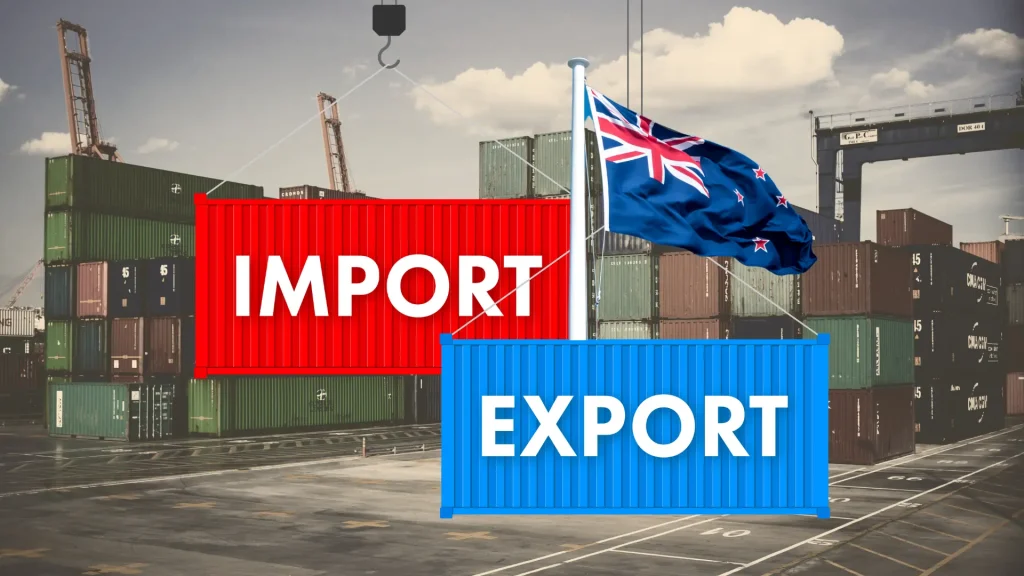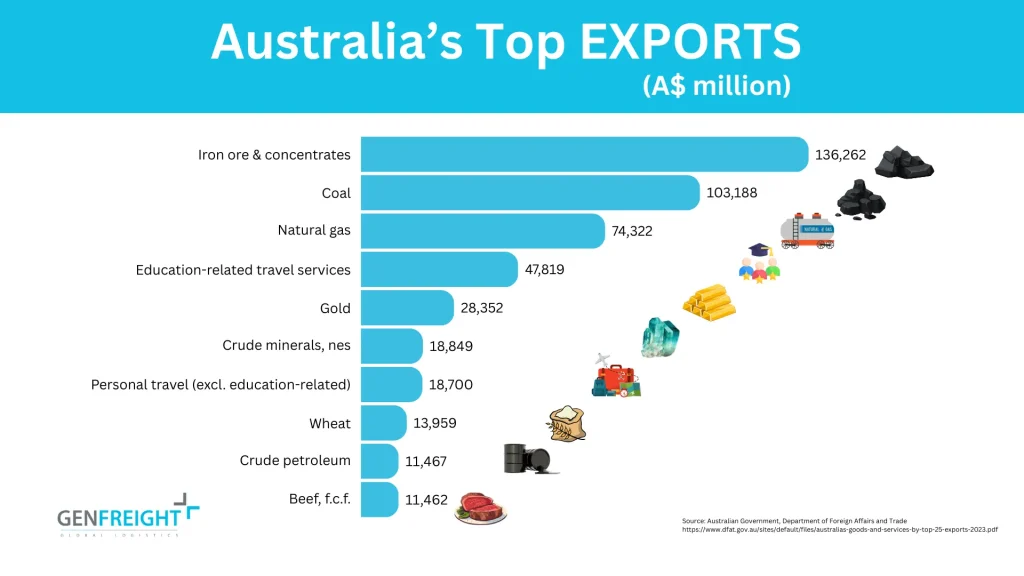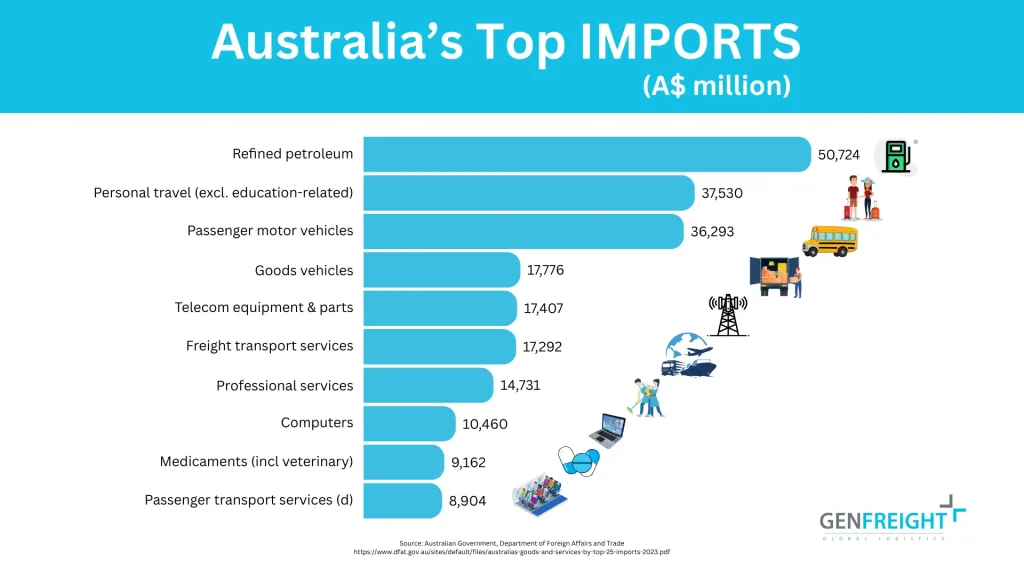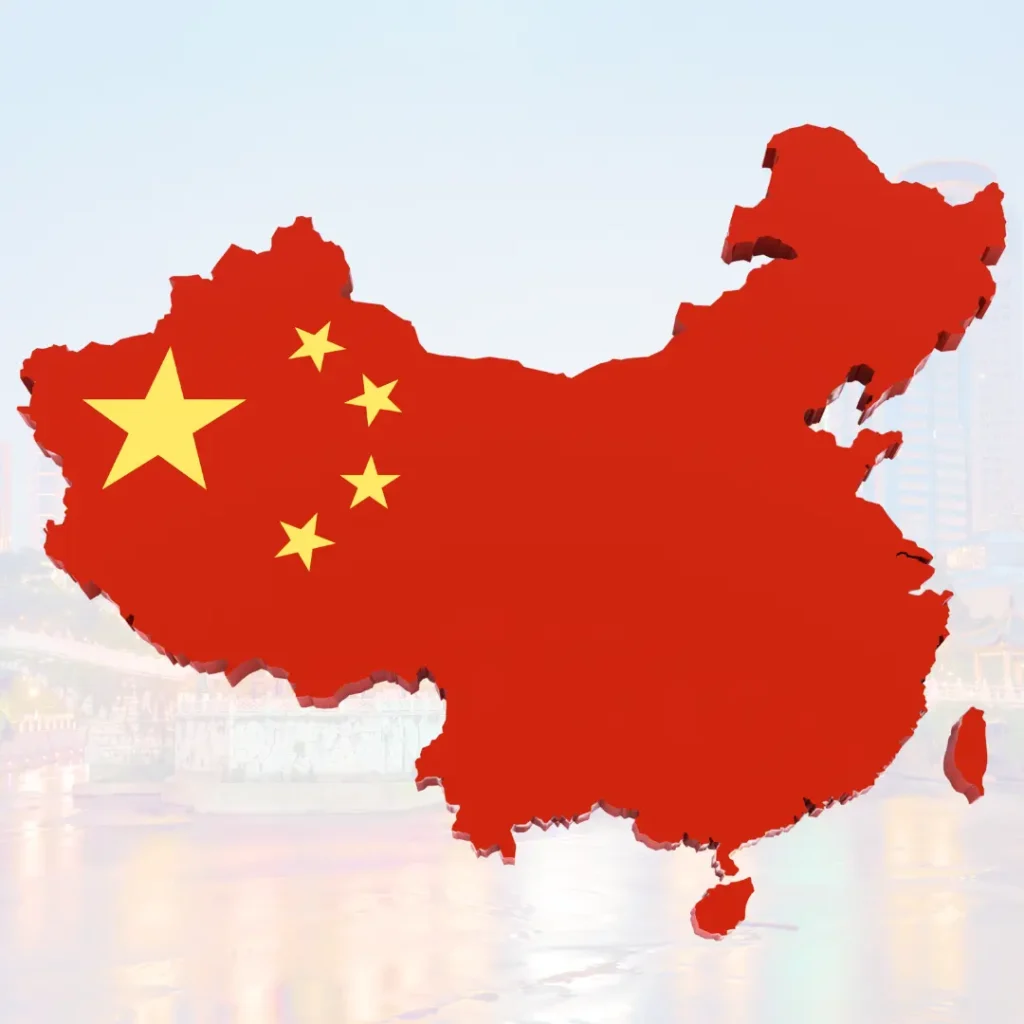In a world marked by economic uncertainty, Australia’s trade balance continues to showcase its impressive strength. Even though exports and imports slightly decreased in August 2024, the country still achieved a positive trade balance of AUD 7 billion. This consistent performance highlights Australia’s role as a key participant in global trade.
This article explores Australia’s top imports and exports, examining the reasons behind these trade movements. It also examines the countries that support Australia’s international trade relationships. Additionally, we will look at emerging trade trends and discuss future opportunities for Australian businesses. These insights can help businesses make the most of opportunities in this dynamic market.

Australia: A Global Export Powerhouse
Australia’s strong economy and rich natural resources have secured its position as a key player in the global trade landscape. Additionally, the country’s remote location and unique environment provide a wide variety of valuable goods, such as minerals and crops. This natural wealth, along with a skilled workforce and stable politics, makes Australia an appealing trade partner. The demand for Australian exports is driven by several factors, including:
- High-Quality Products. Firstly, Australia is famous for producing high-quality goods, particularly in agriculture, mining, and manufacturing.
- Reliable Supply. Secondly, the country’s stable political and economic environment ensures a reliable supply of goods and services.
- Strong Trade Relationships. Thirdly, Australia has built strong trade relationships with major economies, such as China, Japan, and the United States.
- Innovative Industries. Finally, investments in research and development have supported new industries, like renewable energy and medical technology.
What are Australia's top exports?
Let’s explore the top 10 export industries driving the nation’s economy:
- Iron Ore & concentrates. (A$136,262m) Similarly, as a vital part of steel production, iron ore remains a major export. Particularly China is the biggest buyer.
- Coal. (A$103,188m) This fossil fuel remains a significant contributor to Australia’s export earnings, primarily driven by demand from China, Japan, and India.
- Natural Gas. (A$74,322m) Additionally, Australia’s large natural gas reserves and investments in liquefied natural gas (LNG) infrastructure make it a top exporter.
- Education-Related Travel Services. (A$47,819m) Furthermore, international students choose Australia’s top education institutions, creating significant export revenue for the nation.
- Gold. (A$28,352m) In addition, Australia’s gold mines produce large quantities of this valuable metal, which significantly adds to export revenue.
- Crude minerals, nes. (A$18,849m) Consequently, the country is rich in natural resources and has vast reserves of these minerals, which are in high demand globally for various industries.
- Personal Travel Services. (A$18,700m) Moreover, millions of tourists visit Australia yearly for its beautiful landscapes, exciting cities, and unique wildlife.
- Wheat. (A$13,959m) Australia is also a major exporter of wheat, known for its high quality and reliability. The country’s vast, fertile plains, favorable climate, and advanced agricultural techniques contribute to its wheat production, making it a significant supplier to the global market.
- Crude Petroleum. (A$11,467m) While not as significant as other exports, crude petroleum contributes to Australia’s overall export earnings.
- Beef. (A$11,462m) Lastly, Australian beef is highly valued for its quality and safety, making it very popular in global markets.

Emerging Export Opportunities
While traditional commodities remain significant, Australia is also emerging as a global leader in new and exciting export sectors:
- Renewable Energy. Firstly, Australia has abundant solar and wind resources. Therefore, it is positioned to become a top exporter of renewable energy technologies and green hydrogen.
- Critical Minerals. Secondly, the demand for critical minerals, like lithium, rare earth elements, and cobalt, is rising. Consequently, these minerals are essential for electric vehicles, batteries, and other high-tech uses.
- Technology and Innovation. Thirdly, Australia’s strong research institutions and innovative companies are driving growth. As a result, this is happening in sectors like fintech, biotech, and advanced manufacturing. It is also opening up new export markets.
Australia’s Import Landscape
Australia’s economy, while strong, heavily relies on imports to meet domestic demand and support various industries. Several factors contribute to this reliance:
- Geographic Isolation
- Firstly, Australia’s geographical isolation limits its access to global supply chains.
- Additionally, the vast distances between major population centers and production hubs increase transportation costs. This leads to reliance on imported goods.
- Limited Domestic Manufacturing Capacity
- Many manufacturing industries in Australia have declined. This is due to high labor costs and global competition.
- Consequently, Australia depends on imports for a wide range of manufactured goods, such as electronics and automobiles.
- Diverse and Specialised Economy
- Australia’s economy relies heavily on primary industries like mining and agriculture.
- While these industries generate significant export revenue, they often require specialised equipment and technology that may not be produced domestically.
- Consumer Demand for Diverse Products
- Australian consumers have diverse preferences and demand various products. Many of these are not produced locally.
- Therefore, this drives the need for imports to satisfy consumer demand.
- Global Supply Chains and Economies of Scale
- Australia benefits from participating in global supply chains. These often involve importing intermediate goods and components.
- Furthermore, economies of scale in foreign manufacturing lead to lower production costs, making imported goods more affordable for Australians.
- Government Policies and Trade Agreements
- Government policies, such as tariffs and quotas, can influence the level of imports and exports.
- Additionally, free trade agreements can facilitate trade and reduce barriers to entry for foreign goods.
What are Australia's top imports?
According to the report from the Department of Foreign Affairs and Trade, in 2023 Australia imported goods and services in a total amount of A$570,874 million. This is compared to A$399,298 million in 2021. You can find the full report here. Below is a breakdown of Australia’s top imports in 2023 (in A$ million):

- Refined Petroleum. (A$50,724m)Despite abundant natural gas resources, Australia, however, lacks enough domestic refining capacity to meet demand for refined petroleum products.
- Personal Travel Services. (A$37,530m) Also Australia’s vibrant tourism industry attracts millions of international visitors each year. Consequently, this contributes significantly to the country’s import figures.
- Passenger Motor Vehicles. (A$36,293m) The Australian automotive market, therefore, heavily relies on imported vehicles, especially from Japan and Europe.
- Goods Vehicles. (A$17,776m) Additionally, the import of commercial vehicles, such as trucks and buses, supports industries like logistics and transportation. As a result, it benefits the economy.
- Telecom Equipment and Parts. (A$17,407m) Moreover, the rapid advancement of technology and growing demand for digital connectivity. As a result, this drives the import of telecom equipment and parts.
- Freight Transport Services. (A$17,292m) International freight transportation services are crucial for moving goods to and from Australia. Thus, they contribute to the country’s import bill.
- Professional services. (A$14,731m) Furthermore, Australia imports various professional services, including engineering, finance, legal, and education services. This, consequently, highlights the need for a skilled workforce in these sectors to meet domestic demand.
- Computers. (A$10,460m) The demand for computers and related technology drives imports, particularly from countries like China and the United States. Therefore, this impacts Australia’s import figures.
- Medicaments (incl. veterinary). (A$9,162m) Also Australia imports a wide range of pharmaceutical products to meet the healthcare needs of its population. As a result, it ensures access to essential medicines.
- Passenger Transport Services. (A$8,904m) Lastly, international travel, including air and sea travel, contributes to Australia’s import figures.
Factors Influencing Imports
There are everal factors influence Australia’s import patterns:
- Consumer Preferences and Demand. Firstly, the growing demand for high-quality goods and services, particularly from international brands, drives imports.
- Domestic Production Capacity. Secondly, Australia’s relatively small domestic market and limited manufacturing capacity necessitate the import of certain goods.
- Global Supply Chain Disruptions. Thirdly, disruptions in global supply chains, such as those caused by the COVID-19 pandemic, can impact the availability of imported goods. As a result, this can affect the cost of those goods.
- Exchange Rate Fluctuations. Finally, changes in the exchange rate can affect the price of imported goods, influencing import volumes.
Australia's Major Trading Partners
Australia's Top Import Partners
- China. Undoubtedly, China is a major supplier of manufactured goods to Australia. These include electronics, machinery, and textiles. The strong economic ties between both countries have led to increased trade.
- United States. Also the US is a key source of high-tech products, agricultural goods, and services. As a result, trade with the US plays a significant role in Australia’s economy.
- Japan. Japan supplies Australia with automobiles, electronic components, and machinery. Additionally, the historical and cultural ties between the countries have helped build a strong trade relationship.
- South Korea. South Korea is a key supplier of electronics, automobiles, and industrial machinery. Moreover, the Korea-Australia Free Trade Agreement (KAFTA) has helped strengthen economic ties.
- Germany. Germany is a leading exporter of high-quality manufactured goods. These include machinery, automobiles, and chemicals. Germany’s strong export market helps support Australia’s economy.
Australia's Top Export Partners
- China. Firstly, China is Australia’s largest trading partner. There is significant demand for Australian resources, particularly iron ore and coal. Additionally, the China-Australia Free Trade Agreement (ChAFTA) has further facilitated trade between the two countries.
- Japan. Secondly, Japan is a major importer of Australian resources, including coal, iron ore, and liquefied natural gas (LNG). Furthermore, the Japan-Australia Economic Partnership Agreement (JAEPA) has strengthened economic ties.
- South Korea. Thirdly, South Korea is a significant market for Australian resources, particularly coal and iron ore. Moreover, Korea-Australia Free Trade Agreement (KAFTA) has deepened the economic relationship between the two nations.
- India. Fourthly, India is an emerging market with significant potential for Australian exports. These include education, mining, and agriculture. The India-Australia Economic Cooperation and Trade Agreement (IndAus ECTA) aims to boost bilateral trade and investment.
- United States. Finally, the US is a major market for Australian agricultural products, such as beef and wine. Additionally, the strong strategic alliance between the two countries has contributed to increased trade in other sectors.
A Deeper Dive into Australia's Major Trading Partners
China
- Economic Powerhouse. Firstly, China remains Australia’s largest trading partner. There are significant trade flows in commodities like iron ore, coal, and natural gas.
- ChAFTA’s Impact. The China-Australia Free Trade Agreement (ChAFTA) has further strengthened bilateral trade. So it has reduced tariffs and made market access easier.

- Future Outlook. While geopolitical tensions may introduce complexities, China’s continued economic growth and infrastructure development will likely sustain demand for Australian resources. However, recent political tensions and trade disputes between the two countries may impact future trade relations.
Japan

- Long-Standing Partnership. Firstly, Japan has been a key trading partner for Australia for decades. Also the countries share strong ties in areas like automotive manufacturing, education, and tourism.
- Economic Interdependence. Secondly, both countries benefit from a mutually beneficial trade relationship. For example Japan imports Australian resources and exports manufactured goods
- Future Outlook. Thirdly, the Japan-Australia Economic Partnership Agreement (JAEPA) has further deepened economic ties. So future collaboration in areas like technology and innovation is expected to strengthen the partnership.
South Korea
- Rising Economic Power. Firstly, South Korea hasbecome as a significant trading partner for Australia. So trade in resources, agricultural products, and manufactured goods continues to grow.
- Korea-Australia Free Trade Agreement (KAFTA). Additionally, KAFTA has facilitated increased trade flows and investment between the two countries.

- Future Outlook. Furthermore, the growing demand for clean energy and sustainable resources in South Korea presents opportunities for Australian exporters. Moreover, these opportunities are especially significant in the renewable energy sector.
India

- Emerging Market. India’s rapid economic growth has made it an important market for Australian exports, particularly in education, mining, and agriculture. As a result, it offers great potential for future trade growth.
- India-Australia Economic Cooperation and Trade Agreement (IndAus ECTA). This agreement aims to boost bilateral trade and investment. In particular, the focus is on education, agriculture, mining, and services.
- Cultural Considerations. Understanding cultural differences and building strong business relationships are crucial for success in the Indian market. Therefore, fostering cultural awareness can lead to more fruitful partnerships.
United States
- Strategic Alliance. Firstly, the United States is a key strategic and economic partner for Australia.
- Diverse Trade Relationship. Secondly, trade between the two countries covers a wide range of products and services from agricultural goods to advanced technologies.

- Future Outlook. Thirdly, the strong bilateral relationship and shared security interests are expected to support continued growth in trade and investment. However, recent global economic trends and geopolitical shifts may influence the future trajectory of this relationship.
Future Outlook
Challenges Facing Australian Trade
While Australia has a strong foundation in international trade, several challenges may impact its future growth:
- Global Economic Slowdow. Firstly, a global economic downturn can reduce demand for Australian exports, particularly commodities like iron ore and coal.
- Climate Change. Secondly, climate change poses significant risks to Australia’s resource-based industries, including agriculture and mining. For example extreme weather events, such as droughts and floods, can disrupt production and supply chains.
- Geopolitical Tensions. Thirdly, geopolitical tensions and trade disputes can disrupt global trade flows and increase uncertainty for businesses.
Emerging Opportunities
Despite these challenges, Australia has several opportunities to strengthen its position in the global economy:
- The Rise of the Asian Middle Class. Firstly, the growing middle class in Asia, particularly in China and India, presents significant opportunities for Australian exporters. In particular, the demand for high-quality goods and services, such as luxury goods, education, and tourism, is rising.
- Digital Trade. Secondly, the increasing importance of e-commerce and digital platforms can open up new markets for Australian businesses. As a result, Australian companies can tap into a wider customer base.
- Sustainable and Ethical Trade. Thirdly, consumers are becoming more conscious of environmental and social issues. Therefore, Australian businesses that prioritise sustainability and ethical practices can gain a competitive advantage in global markets.
- Investment in Education and Skills. Lastly, a well-educated and skilled workforce is essential for Australia’s future economic prosperity. In addition, investing in education and training helps develop the skills needed to compete in a globalized economy.
Navigating the Future
To overcome these challenges and seize new opportunities, Australian businesses should consider the following strategies:
- Diversify Export Markets. Firstly, expanding into new markets, particularly in Southeast Asia and Africa. As a result this can reduce reliance on traditional markets and mitigate risks.
- Build Resilient Supply Chains. Secondly, diversifying supply chains and implementing strong risk management strategies can help to minimise disruptions.
- Embrace Digital Technologies. Thirdly, adopting digital technologies can improve efficiency, reduce costs, and enhance customer experiences.
- Prioritise Sustainability. Moreover, adopting sustainable practices can improve brand reputation and attract environmentally conscious consumers.
- Invest in Innovation. Lastly, research and development can lead to the development of new products and services. Consequently, this drives economic growth and creates jobs.
Government Policies and Initiatives
The Australian government plays a crucial role in promoting international trade and investment. Through various policies and initiatives, the government aims to create a favorable business environment, support exporters, and attract foreign investment.
Free Trade Agreements (FTAs)
- Strategic Partnerships. Firstly, Australia has actively pursued a network of FTAs with key trading partners, including China, Japan, South Korea, the United States, and the European Union.
- Reduced Tariffs and Barriers. Secondly, FTAs eliminate or reduce tariffs and other trade barriers, making Australian goods and services more competitive in international markets.
- Market Access. Thirdly, FTAs provide preferential market access for Australian exporters. Thus, they help level the playing field with competitors.
Export Finance and Insurance
- Export Finance Australia (EFA). Firstly, EFA provides financing and insurance solutions to Australian exporters. So this helps mitigate risks associated with international trade.
- Supporting Small and Medium-Sized Enterprises (SMEs). Also EFA offers tailored financial products to help SMEs enter new markets. In turn, this allows SMEs to expand their export operations.
- Risk Mitigation. Moreover, by providing insurance coverage, EFA helps exporters protect their investments. Therefore, it enables them to manage risks associated with political instability, currency fluctuations, and other unforeseen events.
Conclusion:
Australia’s dynamic trade landscape offers many opportunities for businesses to get involved in international trade. By understanding the country’s top imports and exports, major trading partners, and government policies, businesses can make smart. Moreover, this will help them take advantage of new trends.
Whether you’re already established in the Australian market or considering expanding your international operations, this article has provided valuable insights into the factors shaping Australia’s trade future.
If you’re looking for a reliable and experienced partner to handle your logistics needs in international trade, contact GenFreight. With our expertise in freight forwarding, customs clearance, and supply chain management, we can help you navigate the complexities of global trade.
